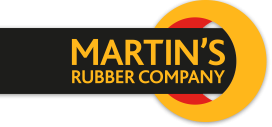What are the different types of rubber?
Posted on 27/01/2020 Category: Technical Features

Rubber is an incredibly versatile, all-purpose material that is used across a huge range of domestic and industrial applications. From the natural rubber derived from rubber trees through to an extensive array of synthetic rubbers, there really is a rubber material for every occasion. In this article, Martin’s Rubber explores 10 different types of rubber parts, highlighting their advantages, disadvantages, and typical uses.
10 different types of rubber
As we know, rubber is flexible. Not just in terms of its elastic and malleable mechanical properties. Rubber’s chemical properties also make it incredibly attractive for elastomer engineering a wide variety of different types of synthetic rubber combine the best properties of natural rubber with a host of beneficial extra traits.
Here, we will look at 10 different types of rubber parts used today.
1. Natural Rubber (NR)
Natural rubber (Isoprene) is derived from the latex sap of the Pará rubber tree (Hevea brasiliensis). Natural rubber has a high tensile strength and is resistant to fatigue from wear, such as chipping, cutting, or tearing. The downside is that natural rubber is only moderately resistant to heat, light, and ozone damage. Natural rubber is used in gaskets, seals, shock mounts, hoses, and tubing.
2. Styrene-butadiene rubber (SBR)
Styrene-butadiene rubber is a low-cost synthetic rubber with good abrasion resistance, outstanding impact strength, resilience, and high tensile strength. However, SBR offers poor resistance to sunlight, ozone, steam, and oils. The main applications of styrene butadiene rubber include tyres and tyre products, automotive parts, and mechanical rubber goods.
3. Butyl (IIR)
Butyl rubber is an excellent option for shock absorption. It offers exceptionally low gas and moisture permeability and outstanding resistance to heat, ageing, weather, ozone, chemical attack, flexing, abrasion, and tearing. Butyl is resistant to phosphate ester-based hydraulic fluids and has excellent electrical insulation properties. It tends to trap air, blister, and creep during manufacture. Typical applications include O-rings, tank liners, and sealants. Its impermeability to gas makes butyl ideal for seals in vacuum applications.
4. Nitrile (NBR)
Nitrile (NBR rubber and Buna-N) is the seal industry’s most widely used and economical elastomer. This is partly because it is resistant to petroleum-based oils, fuels, water, alcohol, silicone greases, and hydraulic fluids. Nitrile has a temperature range of between -54 and +149 degrees Celsius and has a good balance of desirable properties like low compression set, high abrasion resistance, and high tensile strength. Using automotive brake fluid, ketones, phosphate ester hydraulic fluids, and nitro or halogenated hydrocarbons is not advisable.
5. Neoprene (CR)
Neoprene, classified as a general-purpose elastomer, is unusual because it is moderately resistant to petroleum oils and weather (ozone, UV, oxygen). It is, therefore, uniquely qualified for specific sealing applications where many other materials would fail. It has a relatively low compression set, good resilience and abrasion, and is flex cracking resistant. Neoprene shares the same operational temperature range as nitrile and is commonly used to seal refrigerators in air conditioners and refrigeration units.
6. Ethylene Propylene Diene Monomer (EPDM)
EPDM rubber is a versatile type of rubber offering excellent heat, ozone, weathering, and ageing resistance, as well as low electrical conductivity, low compression set, and low-temperature properties. EPDM can be a cost-effective alternative to silicone and, when installed in the correct environment, can last long before embrittling. EPDM rubber is used across various HVAC and automotive applications, as well as in O-rings and electrical insulation products.
7. Silicone (Q)
Silicone performs well with water, steam, or petroleum fluids. Although it can operate within a temperature range of -84 to +232 degrees Celsius, silicone has been shown to withstand short exposures to lows of -115 degrees Celsius. Silicone exhibits poor tear resistance, abrasion, and tensile strength, making it better suited to static rather than dynamic applications. Silicone’s chemical stability means it is commonly used in the food and beverage and medical industries, as well as in sealants, lubricants, and circuit boards, to name but a few.
8. Viton (FKM)
Viton is a fluoroelastomer material capable of handling a diverse array of applications. A brand name of DuPont, this durable synthetic rubber and fluoropolymer elastomer offers exceptional temperature stability ranging from -20 degrees Celsius to +205 degrees Celsius. The disadvantages of Viton are that it can swell in fluorinated solvents, is relatively costly, and can fail rapidly if the wrong grade is used. Along with nitrile, it is one of the most common rubber compounds used for sealing applications, including O-rings, gaskets, and seals.
9. Polyurethane (AU)
Polyurethane is well regarded for its all-round general toughness and notable abrasion and extrusion resistance. O-rings made from polyurethane material would not be suitable for applications requiring good compression and heat resistance. The latter is due to a narrower operational temperature range of between -54 and +100 degrees Celsius. Polyurethane O-rings are often used for hydraulic fittings, cylinders, valves, and pneumatic tools.
10. Hydrogenated Nitrile (HNBR)
Hydrogenated nitrile rubber compounds exhibit better oil and chemical resistance than nitrile rubbers and can withstand much higher temperatures. HNBR promises excellent resistance to oils, fuels, chemicals, steam, and ozone. It also offers exceptional tensile and tear strength, elongation, and abrasion resistance. However, HNBR is relatively expensive, offers limited flame resistance, has poor electrical insulation, and is incompatible with aromatic oils and polar organic solvents. HNBR is widely used in the automotive industry and for a wide range of components, including static seals, hoses, and belts, to name but a few.
Find the perfect type of rubber for your application
For more information about the properties of these and several other types of rubber-based solutions, consult our Material Properties Chart or check out our technical articles. To discuss your application requirements with one of our experienced technical experts, please contact Martin’s Rubber; one of our team members will be happy to help.


